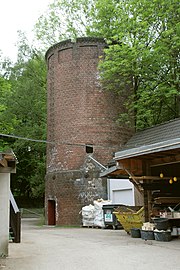Blankenburg colliery
| Blankenburg colliery | |||
|---|---|---|---|
| General information about the mine | |||
| Blankenburg colliery today | |||
| Funding / year | Max. 135,417 t | ||
| Information about the mining company | |||
| Start of operation | 1865 | ||
| End of operation | 1960 | ||
| Funded raw materials | |||
| Degradation of | Hard coal | ||
| Geographical location | |||
| Coordinates | 51 ° 24 '0 " N , 7 ° 15' 36" E | ||
|
|||
| Location | Durchholz - Hammertal | ||
| local community | Witten | ||
| District ( NUTS3 ) | Ennepe-Ruhr district | ||
| country | State of North Rhine-Westphalia | ||
| Country | Germany | ||
| District | Ruhr area | ||
The Blankenburg colliery was a coal mine near the Witten district of Durchholz in the Hammertal . It was created in 1865 through the consolidation of several mines .
Mining history
19th century
Well before 1831 there was underground excavation in the Hammertal, there were already three speculations that consolidated into the Neu-Blankenburg colliery in 1856. On March 1, 1865, the United Geschwind , Friedrich August and Neu-Blankenburg collieries were consolidated under the name of the Blankenburg colliery . In 1870, 29,184 tons were exported from the mine. In 1875, which was Schacht Henry up to 102 meters geteuft . At that time, 80 percent of the hard coal production came from civil engineering , the rest was mined in the Jägerstollen . In 1879 the mining field Leberecht and mining began. In 1880 the output was 45,814 tons.
The horse-drawn tram used until then was replaced by a standard-gauge locomotive train in 1882 . A new briquette factory was also inaugurated . In 1858 45,814 tons of hard coal were extracted from the Blankenburg colliery. The Dorothea Stollenzeche was taken over in 1887. In 1888, the Henry shaft was sunk deeper and the third layer was set at a depth of 204 meters . On April 2, 1890 , the Geviertfeld Hammerthal was awarded and extracted 78,971 tons of hard coal.
In 1891, mining began on the third stage in the Henry shaft. In the same year, operations in the weather chimney and the United Geschwind shaft ceased. The Dorothea Stollenzeche, acquired in 1887, was dismantled from 1893 onwards. The Julius shaft was in operation from 1894, and the Jägerstollen was also dismantled again. The output in 1895 was over 100,000 tons, 105,930 tons of hard coal were extracted from Blankenburg. Until a fan was put into operation in 1898, the mine was only naturally ventilated ; there were now six square fields and seven length fields . In 1900 134,334 tons of coal were exported.
20th century
With the acquisition of the closed colliery Haus Brandenburg in 1902, the entitlement was 10 km², divided into eight square fields and seven length fields . In 1905, the entire workforce of the closed Sprockhövel colliery was taken over, and 123,146 tons of hard coal were extracted. There was a mining shaft, 10 days of hoisting and a tunnel in the mining area. In 1906, the maximum output was reached with 135,417 tons. From 19010, the fourth layer level was set up at a depth of 288 meters.
1911 acquired the Fields St Josephus I and II of the colliery St. Josephus . The United Hammerthal colliery was completely taken over in 1913, but operations continued to be separate. In hunter tunnel was adjusted promoting a 1915th A total of 103,393 tons were extracted this year. Discontinued in the Laurentius Erbstollen just a little later in 1916. In 1918 there were a total of eight square fields (fields United Blankenburg , United Holthausen , United Neu-Scheven , Alexius , United Equality , Ferdinand III , United Kemnade and Egon I ) and new length fields (fields Leberecht , Julius , Dorothea , Freiheit , Rummelskirchen , Nebenbank , Saufberg , St. Josephus I , St. Josephus II and Saldenberg ), a total of around 13 km². In 1919 the pump drive was dismantled, the pit drowned and it had to be swamped .
In 1920, 76,580 tons are driven out of the Blankenburg colliery. In 1921, the swamping of the substations was partially completed, and dismantling began again. In 1924 one shaft, two tunnels and 14 days of overcutting were in operation. The colliery was closed on September 3, 1925, and all authorized persons except Geviertfeld Friedrich August came to the Alte Haase colliery in 1940 .
In 1946 it reopened as the Neu-Blankenburg colliery, which was then renamed Blankenburg on January 1, 1951 and closed on August 31, 1960.
literature
- Wilhelm Hermann, Gertrude Hermann: The old mines on the Ruhr (= the blue books ). 3rd completely revised and expanded edition. Langewiesche, Königstein im Taunus 1990, ISBN 3-7845-6992-7 .
Web links
- Blankenburg colliery
- Headframes in Ruhr mining: Blankenburg
- Historical map
- Map showing the current situation

